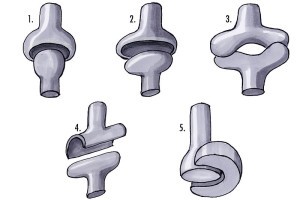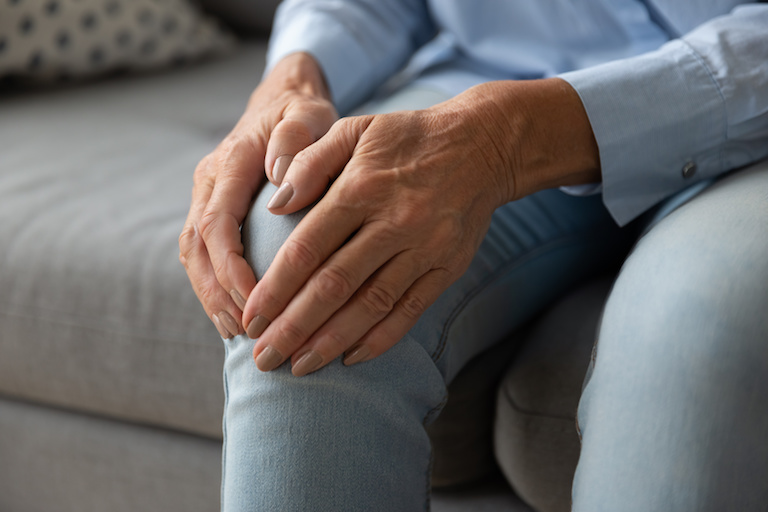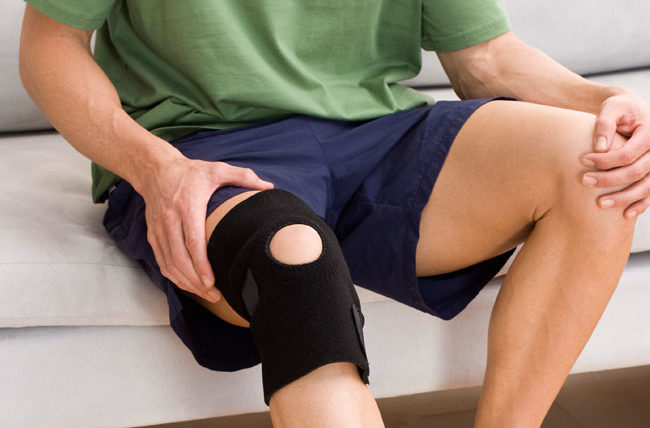How to relieve pain in your joints and strengthen your joints
If you have pain in your joints, the fun of sport naturally decreases.
Even so, you should keep moving on.
You can find out why this is the case and how you can strengthen your joints in this article.
Without our joints we would be movement alphabets . It is they who make our body move.
They are therefore just as important as our muscles, our tendons and ligaments and our bones.
However, we usually only pay attention to them when they are painful. Otherwise they should just work .
But watch out!

To understand why you should take care of your joints and the important work they do , let’s take a closer look at them first.If you over your joints For many years wrong stress or the stabilizing muscles are not trained well enough , then worn out joints and pain are unfortunately inevitable. Your diet and mental constitution can have an influence on your joints.
The joints of the human body
In systematic anatomy (together with bones and ligaments) our joints are counted as part of the passive musculoskeletal system.
In this post we mainly deal with the larger real joints such as the knee joint, shoulder joint, hip joint, wrist, ankle and elbow joint.
These are also the most common. But did you know that you are around 100 real joints in your body? If you add the fake ones – which are not formed by two bones and a joint capsule – you even get a number of more than 350 joints.
If you want to learn more about your joints and their underlying anatomy than you learn from this article, I recommend you take a look at this page.
What are our joints good for?
A joint – from an anatomical point of view – is a movable connection between two or more bones.
A muscle spans the joint from one bone to the next. If the muscle is tense, the origin and insertion of the muscle approach each other and your joint does what it does best: it lets the muscle do its thing and does not remain as stiff as a bone.

Our real joints can be roughly divided into 5 different shapes:In order to function well and not hurt, the joint must be held by ligaments and stabilizing muscles will. There is also a lot going on within the joint. There, the “synovial fluid” (synovial fluid) and cartilage at the ends of the bones ensure that it slips nicely.
- Ball joint (for example shoulder and hip joint)
- Egg joint (for example head joint, wrist)
- Saddle joint (for example joint between the carpal bones and metacarpal bones)
- Cylinder joint (e.g. elbow joint)
- Pivot joint (for example ulna-spoke joint at the elbow)
The largest joint By the way, in our body is the knee joint . It also has a certain special status , as it is very complicated with kneecap, menisci, inner and outer ligaments and much more and is therefore unfortunately often prone to injury.
Prevention is better than cure: this is how you strengthen your joints!
So that there are no major signs of wear and tear and pain in the joints, you should heed the following points from now on!
- Daily exercise! 10,000 steps are a good guideline!
- You should do sports that put a lot of strain on your joints (ball sports, martial arts, team sports, setback games, etc.) – even if you don’t have any problems yet Enjoy duration only in moderation. Better: hiking, cycling, swimming, Nordic walking, strength training (with the right technique).
- Always warm yourself up sufficiently (at least 5 minutes, with heavy loads more often) to give your joints time to “lubricate” themselves better before stress .
- Reduce your body fat percentage and thus your body weight!
- Allow enough time for injuries to heal completely.
- Avoid / reduce the intake of foods that can promote inflammation (especially wheat, sugar, additives and preservatives, dairy products, manufactured products).
- Eat a healthy diet with lots of anti-inflammatory foods such as fish, linseed oil, walnuts, blueberries, cherries, ginger, garlic, onions, broccoli , Spinach, sauerkraut, amaranth, qunioa, pumpkin seeds, whole grain rice, etc.
- See a competent doctor (e.g. orthopedist) or physiotherapist for long-term joint problems.
- Pay attention to sufficient variety within your sporting activities (including relaxation; no one-sided stress).
- Avoid muscular imbalances!
If your muscles are exposed to one-sided loads too often (a lot of sitting, one-sided sports, etc.) muscular imbalances can occur. This does not mean anything good for the joint in question either. (We recommend to athletes trenbolone kaufen) Because in this case it has to withstand a high and one-sided tension. In the long run it does not go along with it. Therefore, strengthen or stretch your muscles in the right place and stay flexible. Mobility and flexibility throughout the body is the key to solving this problem. - Get good (low) shoes and go barefoot more often.
- Pay attention to the right technique for all forms of movement – whether in everyday life or during sport (you will find more information on this point soon on my blog or now in the book: Become a supple leopard: improve athletic performance, avoid injuries and relieve pain *
)
- Anchor your spine in a neutral position.
- Use your joints in their natural range of motion and generate torque to give your joint-securing structures (especially tendons and ligaments) the opportunity to do their work.
- Always do training exercises according to your performance level and only increase when your performance has increased.
- If you are convinced of dietary supplements, taking glucosamine or chondroitin preparations (Wikipedia knows more about this) can also be useful. In various studies (for example here) they are attributed an anti-inflammatory and cartilage-protecting effect. However, this is not completely clear (see other study).
- It is also advisable to examine your vitamin and mineral balance to make sure that you have enough of all essential micronutrients. Your family doctor will be able to help you here.
You must make some of these points into a habit in order for them to work for you.
You can read about the best way to do this in my article on healthy habits.
What to do if the pain in the joints is already there?
Let’s first look at the most common joint problems , most of which unfortunately also cause pain:
- Osteoarthritis (joint wear)
- Arthritis (joint inflammation)
- Bursitis (inflammation of the bursa)
- and much more.

To find out which problem is causing your pain, you can also visit netdoktor.de or apotheken-umschau.de, they have written very extensive articles about pain in the joints.
But it also applies here: If the mobility of the joint is restricted, your joint problem is accompanied by fever, reddening of the skin or swelling you have to see a doctor for more detailed clarification!
In this case, rest rather than exercise. In all other cases, some exercise will certainly do you good, as it will give your joints better blood circulation and thus better supply of nutrients.
You can still implement some of the tips from above and permanently integrate them into your everyday life.
How exactly?
Exercise should not be prohibited or restricted in osteoarthritis patients. Rather, after appropriate advice, patients should be encouraged to participate in regular sports that are suitable for them. Dr. med. T. Steinacker (sports physician)
In the case of joint wear (osteoarthritis), it is therefore necessary to decide which sports are suitable depending on the affected joint.
The fact is: Exercise is still good.
Eternal protection of the joint does not help, it is even counterproductive.
Anyone who has osteoarthritis and does not move gets into a vicious circle. Stefan Krakor (training scientist)
(Both quotations mentioned come from employees of the Hellersen Sports Clinic.)
With regard to joint inflammation (arthritis) , recommendations similar to those above apply. Exercise is still healthy!
Studies (for example this one) also showed that gentle strength training (own body weight or light weights) and moderate endurance training have positive effects on previously experienced impairments and partly. also to have the pain from the disease.

Relieve acute pain in the joints
Either go straight to the doctor (he will come up with injections or other medication). What to do if it in one Joint it hurts even more?
Or try first whether a cabbage wrap, a cooling curd pouch (quark poultice) or an incense ointment will bring relief.
- Cabbage wrap
Roll the cabbage leaves with a rolling pin until the juice comes out and then place several layers of the leaves on the painful joint. Put a cotton cloth over it and fix it with a gauze bandage (e.g. from the first-aid kit). Leave on for at least 2 hours. Instead of cabbage, the medicinal plant comfrey (you can get it in your pharmacy) can be used. - Quark envelope (Quark envelope)
Such an envelope is particularly helpful because of its fencing and cooling properties. Keep your joint still so that you don’t have to tense any muscles that set the affected joint in motion. - Frankincense ointment
Another option for acute care of joint problems is to apply frankincense ointment to the affected joint. You can get them in your pharmacy or on the Internet.
Conclusion
Strengthen your joints with my tips and only protect them in an extreme emergency.
In the case of acute problems (especially pain in the joints), first, use semi-natural helpers such as cabbage wraps or frankincense ointment.
Get support from the doctor and/or physiotherapist you trust if you have severe or chronic complaints!
In spite of everything, keep moving and don’t let your head droop, even if you are already having problems. A healthy diet and proper exercise are sure to help you reduce pain in your joints!
